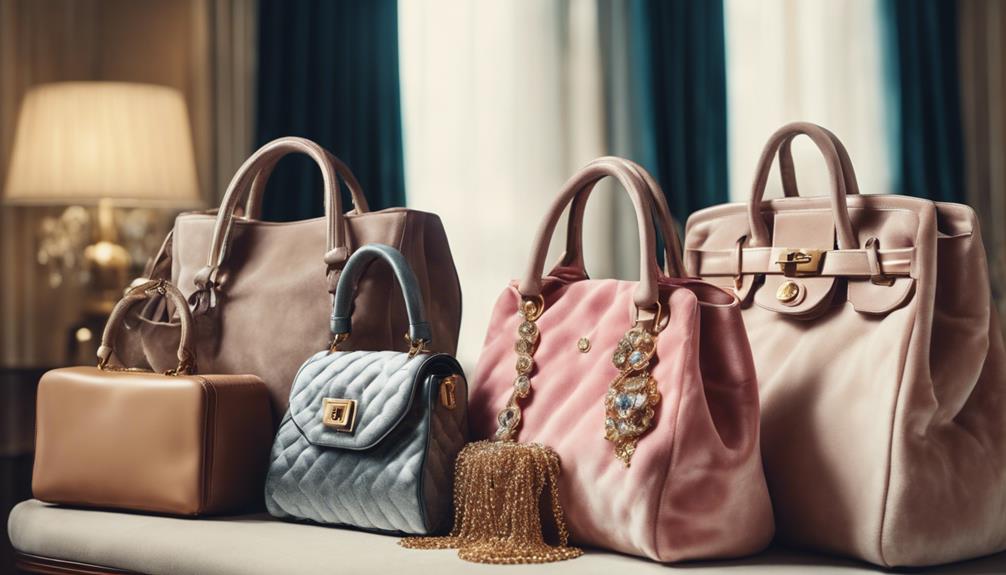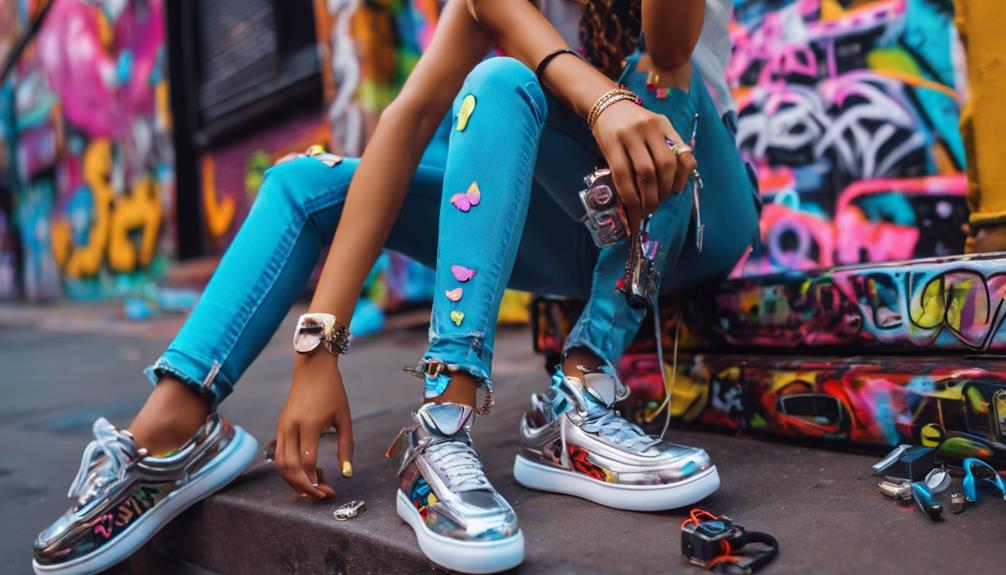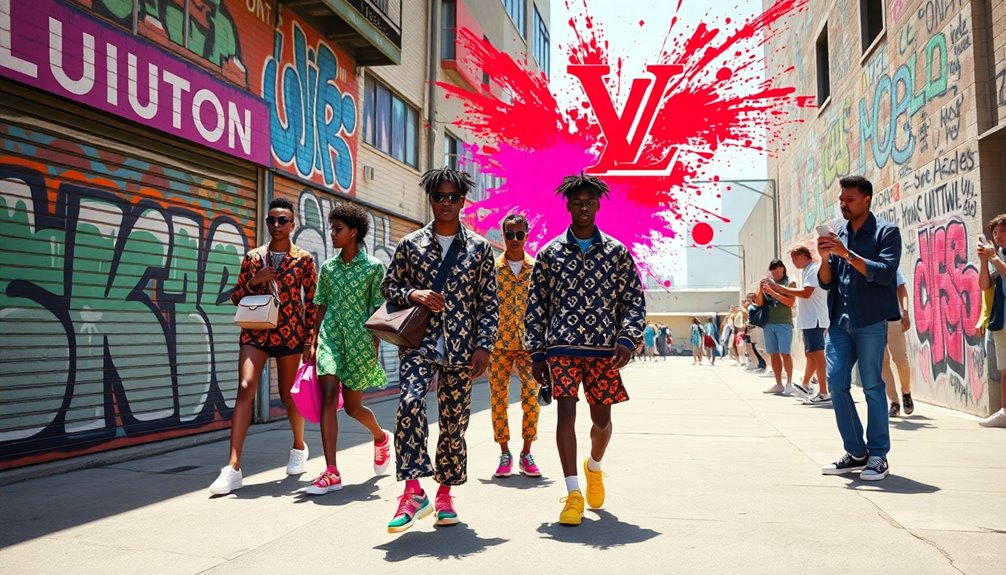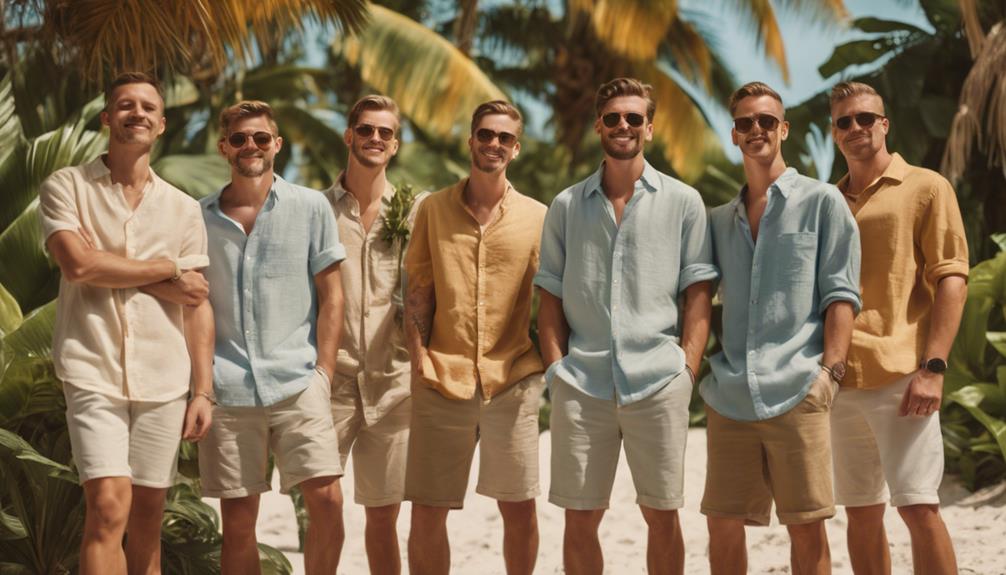Fashion illustration is like a blank canvas, giving you the freedom to unleash your inner designer. By blending traditional influences with modern trends, you can create one-of-a-kind clothing that reflects your personal style. Play around with unique shapes, bold colors, and different fabrics. Don’t forget to mix in some innovative layering techniques while also upcycling old garments to be more sustainable. Each sketch represents a narrative, tying together cultural history with today’s fashion. Explore these techniques further and see your fashion ideas take flight, designing pieces that are authentically you.
Key Takeaways
- Explore historical fashion movements to inspire your designs and understand cultural influences on style evolution.
- Experiment with signature silhouettes and patterns to develop a unique aesthetic that defines your fashion identity.
- Utilize various fabric types and color palettes to enhance the mood and appeal of your clothing designs.
- Incorporate sustainable practices and eco-friendly materials to align your fashion vision with modern environmental standards.
Origin and historical background of the fashion trend/style
Fashion's journey is truly transformative, shaped by cultural icons and movements throughout history.
You can see how artists and designers have influenced styles, reflecting societal changes and values.
As we explore these origins, you'll uncover the rich tapestry that defines today's fashion drawing.
Fashion's Transformative Journey
Clothing has long served as a powerful indicator of social status and wealth, a trend that began taking shape in the 14th century with the emergence of tailored garments.
As you immerse yourself in the world of fashion, you'll notice how styles have evolved dramatically over the centuries. The Industrial Revolution in the 18th and 19th centuries transformed fashion production, introducing mass manufacturing that made clothing accessible to the masses.
Fast forward to the 1920s, when women began to express their inner fashion by embracing more relaxed styles like flapper dresses, challenging traditional gender norms. This shift paved the way for the post-World War II era, where haute couture flourished. Designers like Christian Dior introduced the 'New Look,' characterized by feminine silhouettes that reshaped women's fashion.
In recent decades, the rise of streetwear and fast fashion reflects the influence of youth culture and globalization. These trends drastically change how fashion is created and consumed, leading to a vibrant landscape where anyone can express themselves.
As you explore fashion illustration, remember that each era tells a unique story, inviting you to express your inner designer and contribute to the ongoing journey of fashion.
Cultural Icons and Movements
Cultural icons have profoundly shaped fashion trends throughout history, often reflecting and influencing societal changes in ways that resonate with us today.
Think of fashion designers like Coco Chanel and Yves Saint Laurent, who challenged norms with their innovative styles. The 1920s flapper movement introduced a more liberated, androgynous look, symbolizing women's newfound independence after World War I.
Fast forward to the 1960s and 1970s, and you see the counterculture movement, where icons like Mary Quant popularized mini skirts and bold prints, embracing rebellion and self-expression. The 1980s brought pop culture icons like Madonna and Prince, who fueled the 'power dressing' trend, emphasizing bold silhouettes and vibrant colors as symbols of empowerment.
Today, the intersection of fashion and social movements, such as Black Lives Matter, shows how cultural icons continue to influence contemporary fashion. Designers are increasingly incorporating messages of equality and activism into their collections.
Key Characteristics

When you think about fashion drawing, signature silhouettes and patterns immediately come to mind.
You'll also notice how fabric types and color palettes play a crucial role in conveying a design's essence.
Plus, understanding timeless fashion staples can elevate your illustrations and resonate with audiences.
Signature Silhouettes and Patterns
How do signature silhouettes and patterns shape a designer's identity and communicate their aesthetic vision? They're vital elements that can define your work and set you apart in the fashion world.
Signature silhouettes—like the hourglass, A-line, or boxy cuts—become recognizable trademarks that embody your unique style. By choosing specific patterns, such as florals, stripes, or polka dots, you can evoke distinct moods, enriching your designs and enhancing your brand's visual identity.
Think about how the interplay between silhouette and pattern communicates the message of your collection. The way garments move and drape on the body can transform your designs, making them memorable. Experimenting with mixed media and layering techniques can add depth and texture, allowing your signature silhouettes to stand out even more dramatically.
As an aspiring fashion illustrator, understanding these elements is essential. They help you convey the desired style and emotion in your sketches.
Fabric Types and Color Palettes
Understanding fabric types and color palettes can elevate your designs, as they play a crucial role in shaping the overall aesthetic and emotional impact of your collection.
In the world of fashion, knowing the differences between natural fibers like cotton, silk, and wool versus synthetic fibers such as polyester and nylon is essential. Natural fibers offer breathability and comfort, while synthetic options provide durability and resistance to wrinkling.
Each fabric type brings unique characteristics to your designs. For instance, silk adds a luxurious feel with its natural sheen, while denim provides structure and sturdiness.
When it comes to color palettes, you can choose between warm tones—reds, oranges, and yellows that evoke energy—and cool tones—blues, greens, and purples that convey calmness and serenity.
Your choices greatly influence the mood and style of your pieces. Bold colors can make a powerful statement, while muted tones suggest sophistication.
Timeless Fashion Staples
Timeless fashion staples, like the little black dress and tailored blazer, embody versatility and enduring appeal that every wardrobe needs. These classic pieces are characterized by their ability to transcend trends, offering you a solid foundation for your personal style and vision.
Whether it's a well-fitted pair of jeans or a crisp white shirt, these staples are designed to mix and match effortlessly, allowing you to create multiple outfits with ease. Neutral colors and simple silhouettes define these pieces, making them easy to style for any occasion.
High-quality materials such as wool, cotton, and silk guarantee that they not only look polished but also last through the years. Investing in timeless fashion staples means you're choosing durability and sophistication over fleeting trends.
These iconic items help people express their uniqueness while staying rooted in classic fashion principles. By incorporating timeless pieces into your wardrobe, you'll find that you can effortlessly navigate various seasons and events, all while maintaining a chic and polished appearance.
Embrace these essential staples to elevate your style and enjoy the confidence they bring.
Modern Interpretation

In today's fashion drawing scene, you're likely to see a strong focus on sustainable innovations and emerging eco-friendly labels that resonate with a conscious audience.
Fashion icons of the decade are setting the tone, showcasing styles that marry aesthetics with environmental responsibility.
This shift not only influences your illustrations but also inspires a more thoughtful approach to design.
Sustainable Fashion Innovations
Sustainable fashion innovations are reshaping the industry by prioritizing eco-friendly materials and practices that greatly reduce waste. Brands like Stella McCartney are leading the way by incorporating organic cotton and recycled polyester into their collections. This shift towards sustainable fashion not only benefits the environment but also encourages consumers to rethink their purchasing habits.
One of the key concepts driving these innovations is the circular fashion model, which promotes recycling and upcycling garments. It encourages you to engage in clothing exchanges and repair initiatives, extending the lifecycle of fashion items and reducing landfill contributions.
Moreover, advancements in fabric technology, such as bio-fabrication, are paving the way for materials like mycelium leather developed by companies like Bolt Threads. These lab-grown options considerably lower the environmental impact.
Digital fashion is also on the rise, with virtual clothing designed for avatars minimizing physical production. This trend contributes to a more sustainable fashion ecosystem.
Emerging Eco-Friendly Labels
Emerging eco-friendly labels are transforming the fashion landscape by emphasizing innovative materials and ethical production practices that resonate with conscious consumers. You'll find these brands prioritizing sustainable materials, like organic cotton and recycled fabrics, which help reduce environmental impact. By choosing to support these labels, you're making a statement about your commitment to the planet.
Many of these brands are dedicated to ethical production practices, ensuring fair wages and safe working conditions for the artisans and laborers creating their pieces. They also adopt low-impact dyes and waterless dyeing techniques, which greatly minimize water consumption and pollution. This approach not only protects the environment but also enhances the quality of the garments you wear.
Additionally, some emerging labels focus on circular fashion, designing clothes that can be easily repaired, reused, or recycled. This promotes a waste-free lifestyle, encouraging you to rethink how you consume fashion.
Transparency is another core value of these brands, as they provide detailed supply chain information to foster trust and informed purchasing decisions. By choosing eco-friendly labels, you're not just updating your wardrobe; you're participating in a movement toward a more sustainable future.
Fashion Icons of the Decade
Fashion icons like Rihanna and Harry Styles have boldly challenged traditional gender norms, blending styles that resonate with both personal expression and cultural significance. Their daring fashion choices inspire you to explore your own identity, encouraging a more fluid approach to self-expression.
The rise of social media influencers, such as Chiara Ferragni and Aimee Song, has transformed how fashion icons engage with their audiences. They create personal brands that emphasize inclusivity, allowing diverse voices to flourish within the industry. Designers like Virgil Abloh and Alessandro Michele further this mission, pushing for cultural commentary and breaking conventional aesthetics.
Sustainability also plays a vital role in this decade's fashion narrative. Icons like Stella McCartney advocate for eco-friendly practices, reminding you that style doesn't have to come at the expense of the planet.
Brands like Savage X Fenty and Aerie champion body positivity and inclusivity, showing that true beauty encompasses all shapes and sizes.
Styling Tips

When it comes to styling, the classic white button-up shirt is your best friend, offering endless versatility.
You can experiment with layering techniques and mix textures and patterns to create standout looks that truly reflect your personal style.
Let's explore how to elevate your outfits by mastering these essential styling tips.
Classic White Button-Up Shirt
The classic white button-up shirt is your go-to piece for effortlessly shifting between casual and formal looks.
To style it step by step, start by tucking it into high-waisted trousers or a pencil skirt. This creates a flattering silhouette that emphasizes your waist, enhancing the human figure beautifully. For a polished, sophisticated vibe, layer a fitted shirt under a tailored blazer, perfect for business meetings or professional events.
If you're aiming for a relaxed weekend outfit, pair your white button-up with distressed jeans and ankle boots. This combination offers a chic, laid-back style that's ideal for brunch or casual outings with friends.
Don't forget to let your imagination run wild with accessories! Adding statement jewelry, like bold necklaces or colorful scarves, can infuse personality into your otherwise simple shirt, making it uniquely yours.
Layering Techniques for Versatility
Exploring layering techniques can transform your wardrobe, allowing you to mix and match pieces for a variety of styles and occasions. When you master layering, it becomes much easier to create outfits that reflect your unique personality. Start with a base layer, like a fitted top, and build from there. Add a cardigan or a lightweight jacket for warmth and style. This method works wonders for any season, as you can easily adapt your look to suit the weather.
Around the world, fashion enthusiasts utilize layering to enhance their outfits. Try experimenting with different lengths and silhouettes; a longer piece under a cropped jacket can create a visually appealing contrast. Play with color and texture to add depth and dimension to your look.
Don't forget about accessories—they're essential in the layering game. Scarves, belts, and hats can elevate your outfit while providing functionality. Effective layering not only showcases your creativity but also allows for quick adjustments throughout the day, keeping you stylish from morning meetings to evening outings.
Embrace these techniques, and you'll see how versatile your wardrobe can truly be!
Pairing Textures and Patterns
Pairing textures and patterns can elevate your outfits, creating a dynamic look that showcases your style. Start by mixing different textures, like a soft cashmere sweater with a structured leather skirt. This combination adds visual interest and depth, making your ensemble more engaging.
When you immerse yourself in patterns, stick to a common color palette. This helps maintain cohesion and harmony, preventing your outfit from looking chaotic. For added balance, play with scale variations; pair a bold floral print with a smaller geometric design. This contrast keeps things interesting without clashing.
Layering is key! Combine materials like denim, silk, and knit to add dimension. This enhances your overall appeal and avoids overwhelming the eye.
Don't forget accessories! A patterned scarf or a textured handbag can serve as focal points, tying together various elements in your outfit. These small additions can greatly impact your style, creating a polished and intentional look.
Shopping Guide
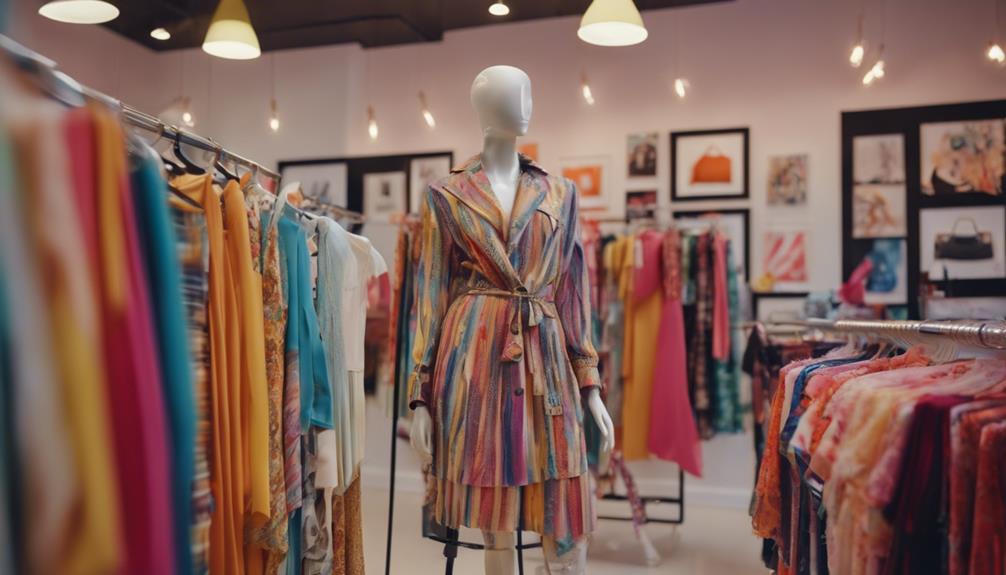
When you're diving into fashion illustration, selecting the right resources and tools can make all the difference in honing your skills. Start with a solid foundation by picking up 'Illustrating Fashion: Concept to Creation' by Steven Stipelman. This user-friendly guide will help you grasp the essentials of fashion illustration.
Next, look for key tools mentioned in the book. Shellac inks are a must-have due to their water resistance and layering capabilities. Additionally, mixed media paper allows you to experiment with diverse artistic techniques.
Don't forget to explore digital options. Apps like Prêt-à-Template offer a library of templates, textures, and patterns to streamline your outfit sketching process across various body types. Investing in fashion drawing apps can also be beneficial, as they provide both free and subscription-based features, giving you access to thorough lessons on professional techniques and current fashion trends.
Lastly, seek out affiliate links for recommended materials and books. This guarantees you're purchasing high-quality, effective tools for your fashion illustration journey. With the right resources, you'll release your creative potential and elevate your design skills.
Upcycling Old Garments
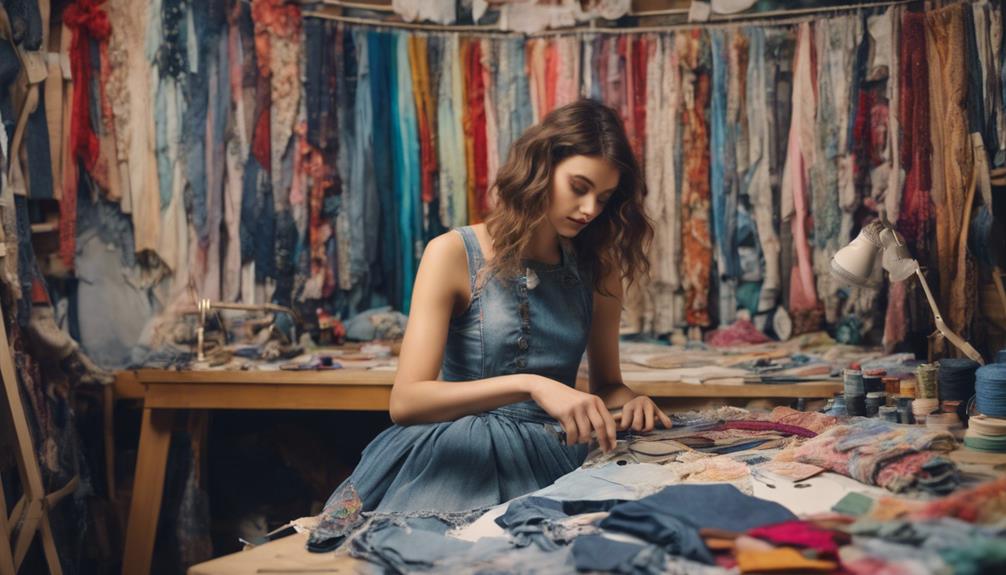
You can give new life to old garments by using fabric paint, personalized embellishments, and patches.
These creative techniques not only make your clothes unique but also reflect your personal style.
Let's explore how you can transform those unwanted pieces into fashionable statements.
Upcycle With Fabric Paint
Upcycling old garments with fabric paint not only sparks creativity but also promotes sustainability by transforming your worn-out clothes into unique fashion statements. You can let your imagination run wild with various types of fabric paint, including acrylic, fabric, and textile paint, each designed for different surfaces and effects.
Before diving into your project, it's essential to pre-wash your garments to eliminate any finishes that might impede paint adhesion. Using a fabric medium can also help maintain the flexibility and durability of your designs. Experiment with techniques like stenciling, sponge painting, or freehand painting to create intricate designs or bold patterns that reflect your personal style.
After applying your paint, allow ample drying time to guarantee the colors set properly. Heat-setting the painted fabric is vital, as it helps the design remain vibrant and withstand washing. This simple step extends the life of your upcycled piece, making sure it remains a standout item in your wardrobe.
With fabric paint, you can breathe new life into old clothes, making each piece a one-of-a-kind creation that showcases your artistic flair and commitment to sustainable fashion.
Personalized Embellishments and Patches
Personalized embellishments and patches can instantly elevate old garments, transforming them into unique fashion statements that showcase your individual style. By adding embroidered patches or decorative stitching, you not only breathe new life into pre-loved items but also express your creativity. This process of upcycling helps reduce textile waste, promoting sustainable fashion practices.
A study by the Ellen MacArthur Foundation reveals that extending the life of clothing by just nine months can cut carbon, water, and waste footprints by 20-30%. So, when you customize your garments, you're making a positive impact on the environment. Plus, personalizing your clothes often increases their emotional value, creating a deeper connection with items you've lovingly altered.
If you're looking for inspiration, online platforms like Etsy and Instagram are treasure troves of DIY embellishment ideas. You can find tutorials that guide you through the process, encouraging you to join a community of fashion enthusiasts who share their upcycled creations.
With just a bit of imagination and effort, you can transform your wardrobe and make a statement that's distinctly yours. So, let your creativity shine and start upcycling today!
Cultural Impact
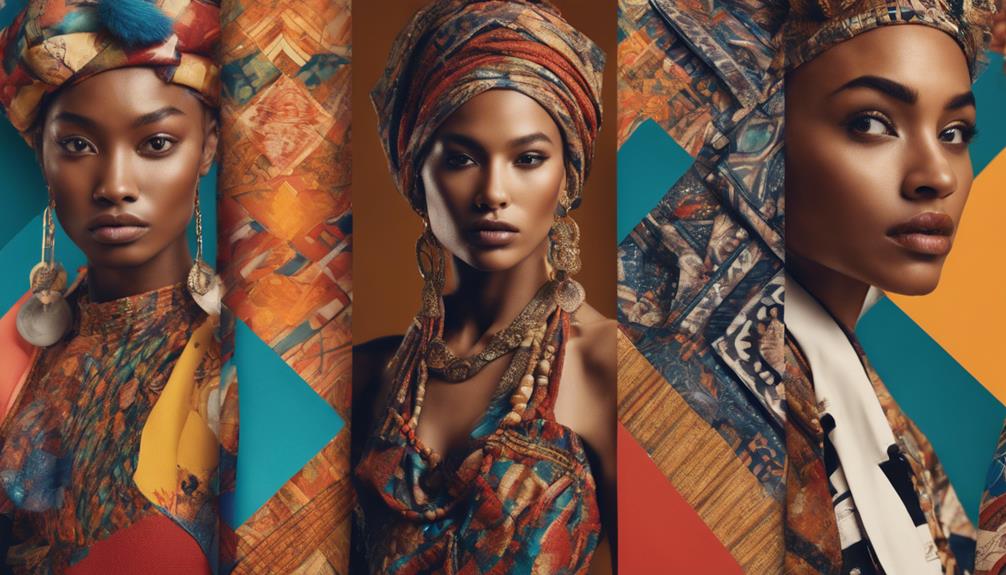
Fashion drawing isn't just about aesthetics; it's a powerful tool that shapes cultural narratives.
When you look at fashion in music videos or its role in political activism, you see how illustrations can influence and reflect societal values.
These visual expressions not only capture trends but also spark conversations about identity and change.
Fashion in Music Videos
Music videos play an essential role in shaping fashion trends, often turning artists into style icons who influence what people wear.
Take Madonna's 'Vogue,' for instance; its high-fashion aesthetics defined the 1990s and inspired countless fans to adopt similar styles. Similarly, Lady Gaga's 'Bad Romance' showcased avant-garde fashion design, solidifying her status as a trendsetter and highlighting the synergy between music and high fashion.
Beyoncé's 'Formation' took it a step further by intertwining fashion with cultural heritage, celebrating Black culture through its striking designs while addressing socio-political issues.
Then there's the rise of streetwear, driven by artists like Travis Scott and A$AP Rocky, which has reshaped the fashion landscape and facilitated collaborations with high-end brands.
These visual spectacles don't just entertain; they greatly influence consumer behavior. You might find yourself inspired to replicate the looks of your favorite artists, affecting retail trends and sales in the fashion industry.
Fashion and Political Activism
Throughout history, fashion has become a powerful tool for political activism, enabling designers and brands to voice social issues and inspire change. You can see this in the feminist statements that emerged in the 1970s and 80s, where clothing became a canvas for empowerment. More recently, the Black Lives Matter movement sparked a wave of fashion activism, with designers like Pyer Moss and brands like Nike using their platforms to promote messages of racial equality and justice.
During the COVID-19 pandemic, many fashion houses adapted quickly, pivoting their production lines to create personal protective equipment (PPE) and masks. This response not only showcased the industry's agility but also its ability to contribute to global crises. You may also notice that fashion weeks now highlight diverse body types, gender identities, and cultural backgrounds, advocating for inclusivity and representation.
Furthermore, brands like Stella McCartney and Patagonia are leading the charge in sustainable practices, emphasizing environmental awareness. They encourage you to reflect on the impact of your choices in fashion. By embracing these movements, you can join a community that values social change and responsible consumption.
Frequently Asked Questions
Can You Still Be a Fashion Designer if You Can't Draw?
You can thrive as a fashion designer without drawing skills. Focus on your strengths in concept development, fabric selection, or collaboration with illustrators to effectively communicate your vision and bring your designs to life.
How Is Drawing Used by a Fashion Designer?
Drawing's your essential tool as a fashion designer. You visualize ideas, experiment with styles, and understand proportions. It helps document your process and communicate concepts, making collaboration with clients and manufacturers smoother and more effective.
What Are the 4 Qualities of a Well Presented Fashion Sketch?
A well-presented fashion sketch showcases clear proportions, vibrant color and texture, meticulous detailing, and effective layout. You'll convey movement, style, and professionalism, turning your sketches into enthralling artistic statements that engage viewers and highlight your designs.
What Are the 3 Methods of Fashion Sketching?
You can explore three methods of fashion sketching: traditional illustration, where you hand-draw designs; digital illustration, where you use software for precision; and mixed media, combining both techniques for richer, more dynamic visuals.
Can Fashion Drawing Skills Help Enhance Styling Abilities?
Fashion drawing skills can unleash your inner stylist by allowing you to visually conceptualize and communicate your ideas more effectively. When you can create detailed sketches of your vision, it enhances your styling abilities by giving you a clear blueprint to follow and share with others in the fashion industry.
Conclusion
In summary, fashion drawing is a vibrant way to express your unique style and creativity.
By understanding its origins and key characteristics, you can embrace modern interpretations and incorporate them into your wardrobe.
Don't forget to explore styling tips and upcycle old garments to make a statement.
As you experiment with your designs, remember the cultural impact of fashion—it's not just about clothing; it's about expressing who you are.
So grab your sketchbook and release your inner designer!

